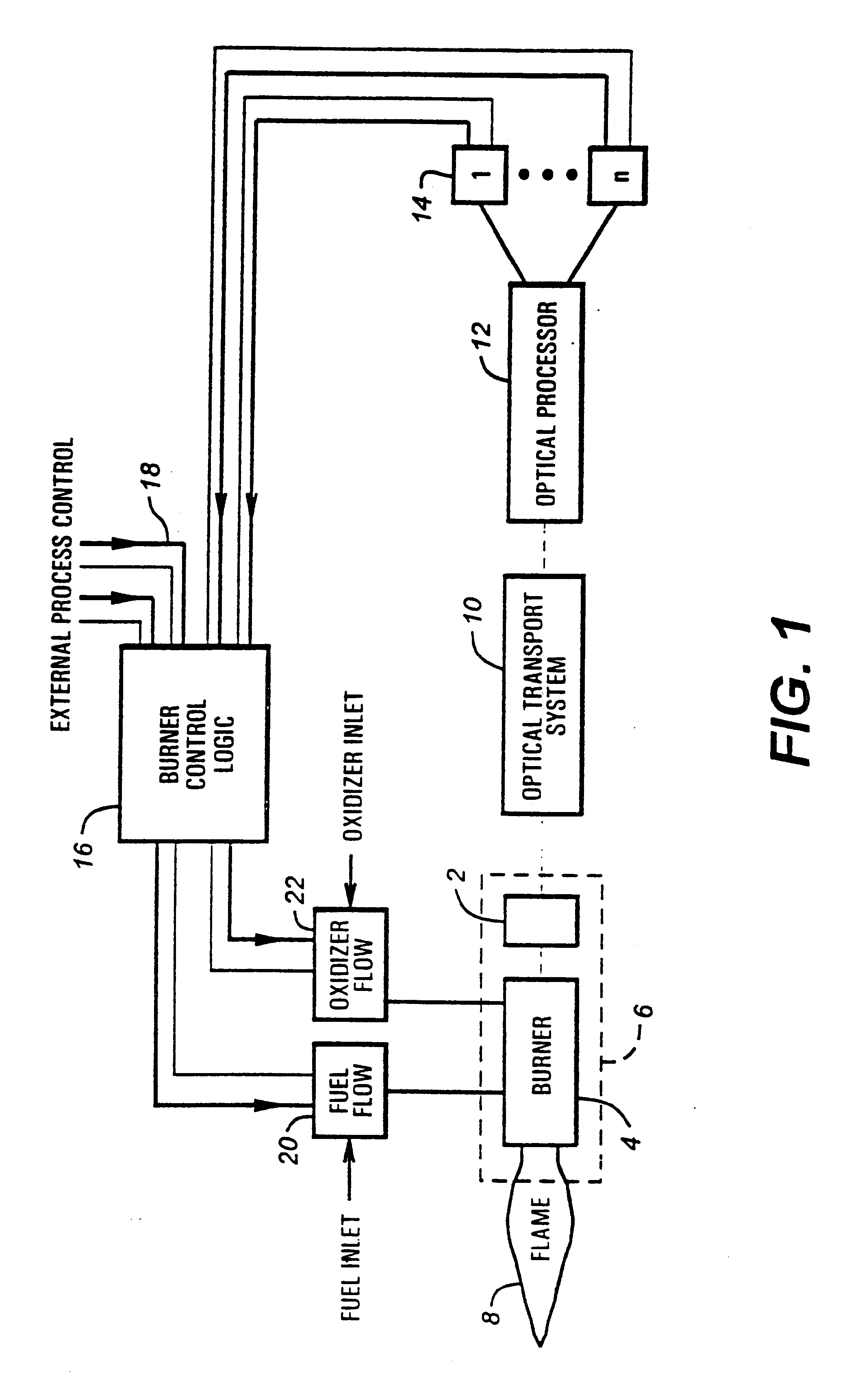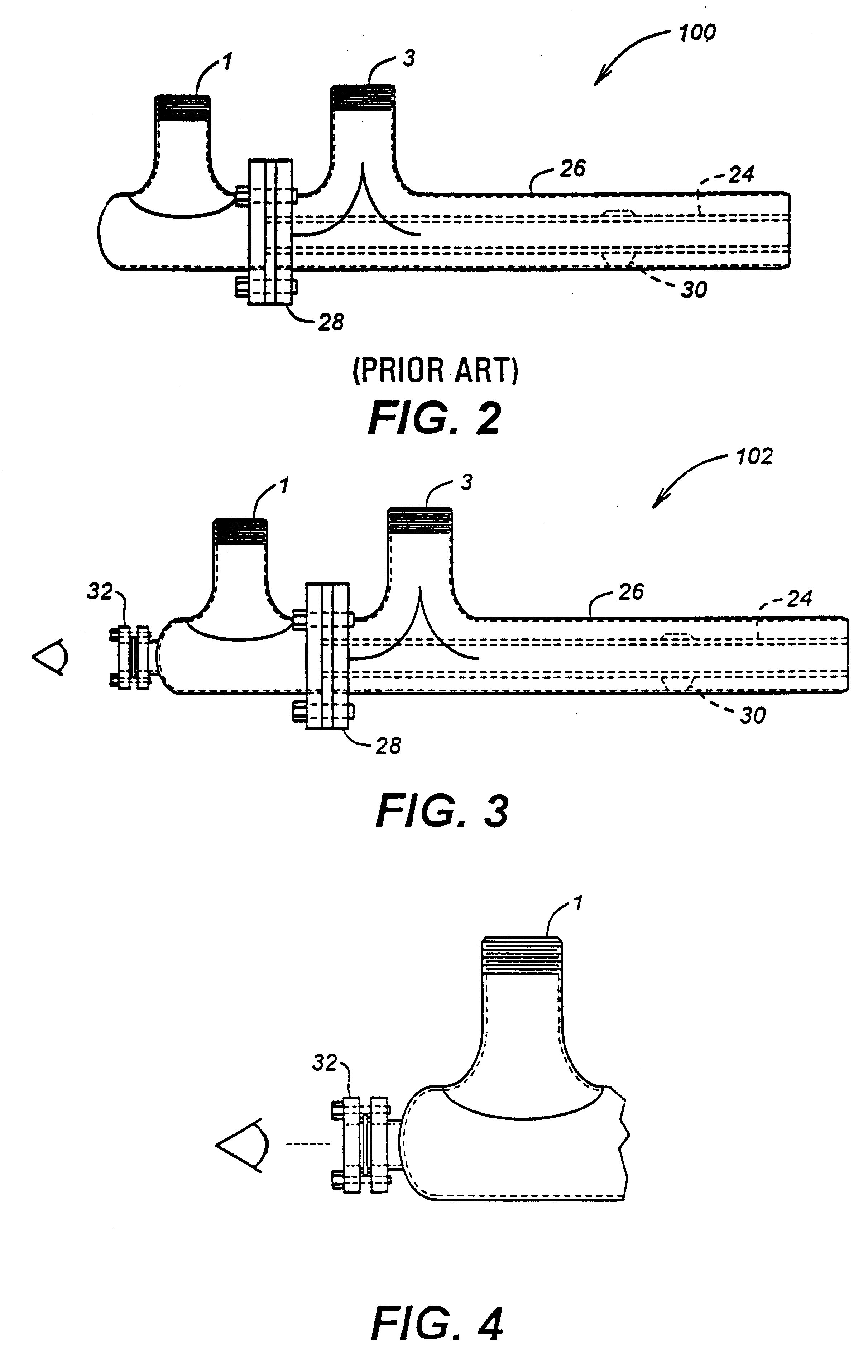Method and apparatus for optical flame control of combustion burners
a technology of optical flame control and burner, which is applied in the direction of combustion regulation, fuel supply regulation, burners, etc., can solve the problems of excessive fuel consumption, nox and co are very dangerous pollutants, and insufficient combustion of fuel,
- Summary
- Abstract
- Description
- Claims
- Application Information
AI Technical Summary
Problems solved by technology
Method used
Image
Examples
example 1
Flame Stoichiometry Monitoring.
A specific region or regions of the spectrum may be monitored to provide information on the flame stoichiometry. For example, in the combustion of natural gas (NG) and oxygen, a strong continuum in the wavelength range of 350-700 nm is present with a maximum occurring near 650 nm. Part of this continuum is thought to result from chemiluminescence from the recombination reaction of CO+O=>CO.sub.2. The strength (intensity) of this continuum has been observed to be related to whether the burner is operating near stoichiometric conditions. When operating under fuel-rich conditions the observed continuum intensity is weaker as compared to slightly fuel-lean or stoichiometric operating conditions.
The effect of stoichiometry on the flame emission spectrum is shown in FIGS. 9 and 10. These spectra were obtained using a fiber optic and lens positioned externally to the burner. Flame emission was collected through the natural gas (NG) injector and window mounted...
example 1.1
Experiments were conducted using a burner and optical coupling as illustrated in FIG. 3. The optical coupling device was attached to a standard burner known under the trade designation ALGLASS available from Air Liquide America Corp., Houston, Tex. The burner had an output of 1.2 MMBtu / hr (using oxygen 99% pure as oxidant) allowing flame emission spectra to be collected through the natural gas (NG) injector. Ultraviolet and visible flame radiation covering a spectral rage of 300-700 nm were collected for different combustion stoichiometries defined in terms of equivalence ratio (.PHI.), wherein: ##EQU1##
For stoichiometric operating conditions, .PHI.=1, whereas for fuel-lean conditions .PHI.1. Results showing the variation of the flame emission spectra for different values of .PHI. are graphically illustrated in FIG. 11. The spectra were obtained using a fiber optic and lens positioned externally to the bumer. Flame emission was collected through the natural gas (NG) injector and win...
example 1.2
The intensity of the emitted flame radiation detected depends on the wavelength region that is being observed. This wavelength dependence results from chemiluminescence of excited state chemical species, continuum emission from atom molecule reactions, and continuum emission from the presence of particles either being entrained or formed in the flame. These effects can be classified as purely chemical, i.e., the observed flame radiation is only a result of the chemical process taking place with no external influences. In addition to the pure chemical effects, other factors can influence the spectrum intensity such as characteristics of how the fuel and oxidizer are mixed, burner, background contributions, entraimnent of chemical species into the flame, furnace, and the method used to collect the radiation, e.g. optical system. Therefore the flame radiation intensity observed in a process can be expressed as a multivariable function:
I.sub..lambda. =.intg..intg..intg..function.(B, S, ...
PUM
 Login to View More
Login to View More Abstract
Description
Claims
Application Information
 Login to View More
Login to View More - R&D
- Intellectual Property
- Life Sciences
- Materials
- Tech Scout
- Unparalleled Data Quality
- Higher Quality Content
- 60% Fewer Hallucinations
Browse by: Latest US Patents, China's latest patents, Technical Efficacy Thesaurus, Application Domain, Technology Topic, Popular Technical Reports.
© 2025 PatSnap. All rights reserved.Legal|Privacy policy|Modern Slavery Act Transparency Statement|Sitemap|About US| Contact US: help@patsnap.com



